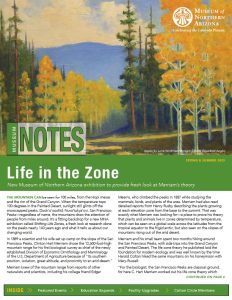

Museum Notes were first published in July 1928, two months before the Museum of Northern Arizona officially opened. That first volume outlined the purpose of the publication: “The purpose of Museum Notes is to keep up the interest in the Society and the Museum; to keep the members and the public in general acquainted with the work of the organization; to keep people informed of accessions and exhibits, and to be a medium for transmitting general museum notes and items of interest.”
Currently published twice a year, Museum Notes continue to inform Museum members of our ongoing work, acquisitions, exhibitions and other activities. See the most recent editions of Museum Notes below. Click on Learn More to download the issue. To stay informed, be sure to also sign up to receive the Museum’s enews.
Museum Notes
Spring/Summer 2025
 THE MOUNTAIN CAN be seen for 100 miles, from the Hopi mesas and the rim of the Grand Canyon. When the temperature tops 100 degrees in the Painted Desert, sunlight still glints off the snowcapped peaks. It’s a fitting backdrop for a new MNA exhibition called Shifting Life Zones, a fresh look at research done on the peaks nearly 140 years ago and what it tells us about our changing world.
THE MOUNTAIN CAN be seen for 100 miles, from the Hopi mesas and the rim of the Grand Canyon. When the temperature tops 100 degrees in the Painted Desert, sunlight still glints off the snowcapped peaks. It’s a fitting backdrop for a new MNA exhibition called Shifting Life Zones, a fresh look at research done on the peaks nearly 140 years ago and what it tells us about our changing world.
Fall/Winter 2024-2025
 ARTISTS CREATE, ANIMALS EVOLVE, plants adapt, and Indigenous cultures flourish. To keep up with this dynamic world, the Museum’s collection continues to grow. Though MNA is approaching its hundredth year, the collection represents a longer timescale, with fossils millions of years old and pottery created by people living here from many centuries ago up to last year. Each year new items are added to the Museum collection.
ARTISTS CREATE, ANIMALS EVOLVE, plants adapt, and Indigenous cultures flourish. To keep up with this dynamic world, the Museum’s collection continues to grow. Though MNA is approaching its hundredth year, the collection represents a longer timescale, with fossils millions of years old and pottery created by people living here from many centuries ago up to last year. Each year new items are added to the Museum collection.
Spring 2024
 DOGS MAY BE MAN’S BEST FRIEND, but people prefer to draw horses. The museum’s art collection contains only a couple images of dogs, but more than a hundred paintings, drawings and sculptures of horses, some of which are on view in the new exhibition “Horse and Rider: A Southwest Story.” The first art piece recorded into the MNA collections was a pencil drawing of two “Horses in a Sandstorm” by Mark Seecody, a Diné boy from Tuba City.
DOGS MAY BE MAN’S BEST FRIEND, but people prefer to draw horses. The museum’s art collection contains only a couple images of dogs, but more than a hundred paintings, drawings and sculptures of horses, some of which are on view in the new exhibition “Horse and Rider: A Southwest Story.” The first art piece recorded into the MNA collections was a pencil drawing of two “Horses in a Sandstorm” by Mark Seecody, a Diné boy from Tuba City.
